Plan and Review of Expense Approval System for Woolworths Retail
VerifiedAdded on 2023/06/15
|10
|2105
|284
Report
AI Summary
This report outlines a plan for developing a new expense approval administrative system at Woolworths to reduce the workload of retail managers and minimize errors in product reordering. The proposed system aims to provide computerized recommendations for approving product orders, thereby optimizing stock refills and reducing economic wastage. The system requirements were identified through internal operations analysis and consultations with stakeholders, including senior management, retail managers, and the Chief Technology Officer. The report includes email correspondence illustrating the consultation process and stakeholder considerations. Key system requirements include scalability for deployment across 995 supermarkets, ease of use for retail managers, compatibility with existing systems, and compliance with quality standards. Quotations from SAP Concur, Web expenses, and internal IT technicians were analyzed using a score-based spreadsheet, indicating that the Concur Expense Management System is the most suitable option. The implementation plan involves physical system development, pilot testing, employee communication using Kotter’s eight-step change model, and staff training. Procedures for system use and communication strategies are detailed to ensure smooth adoption. A risk management plan addresses potential issues such as compliance risks and loss of productivity, emphasizing the importance of training and adherence to procurement policies. The report concludes with a list of references.
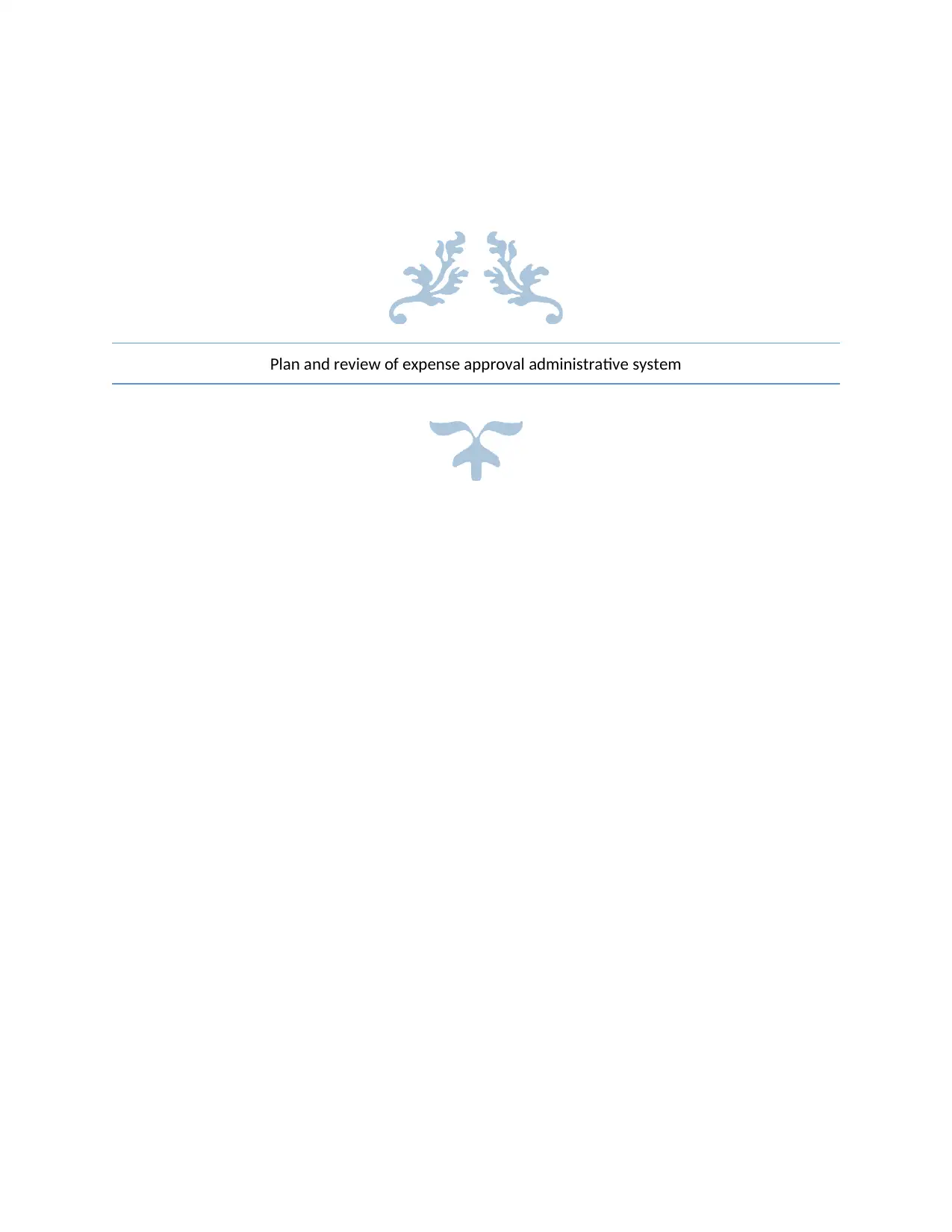
Plan and review of expense approval administrative system
Paraphrase This Document
Need a fresh take? Get an instant paraphrase of this document with our AI Paraphraser
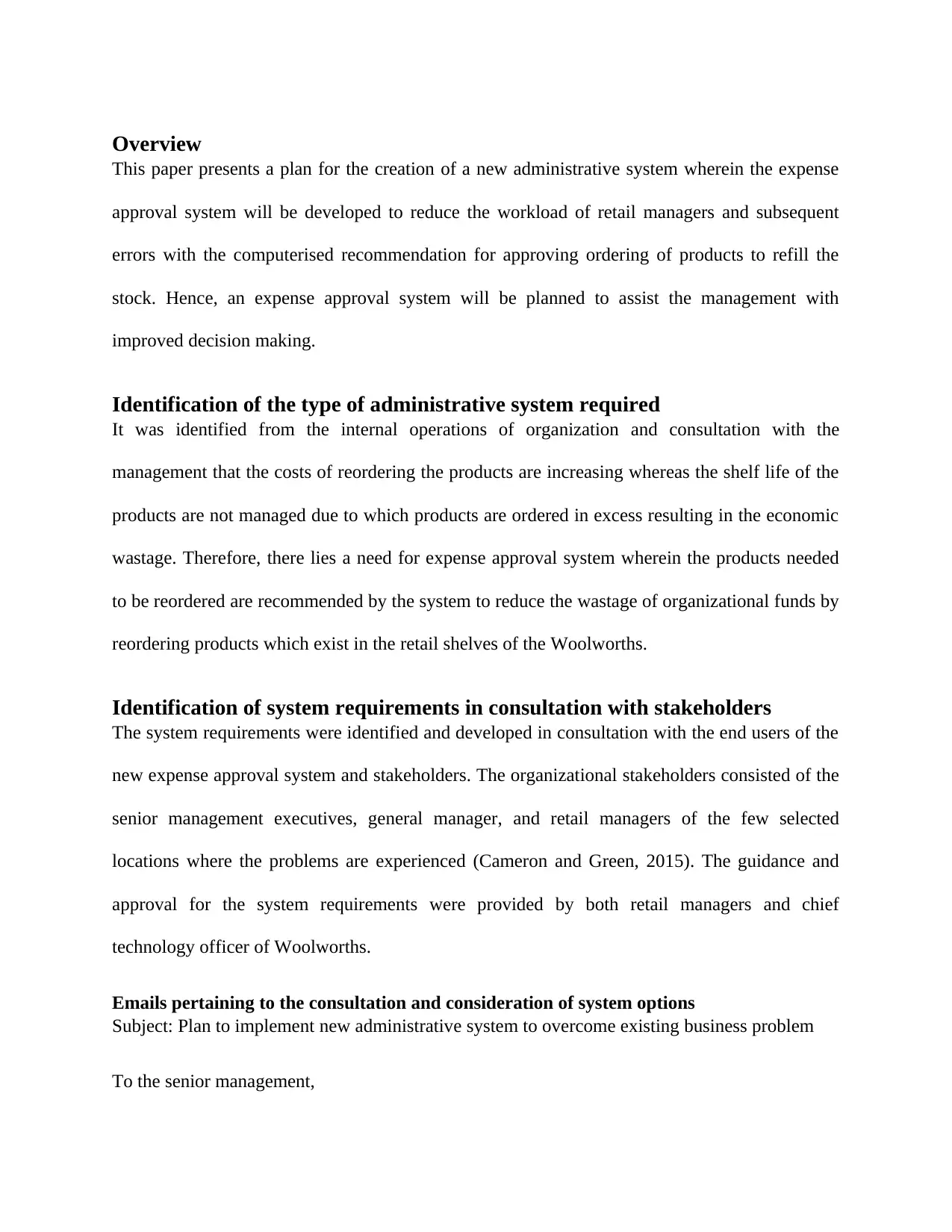
Overview
This paper presents a plan for the creation of a new administrative system wherein the expense
approval system will be developed to reduce the workload of retail managers and subsequent
errors with the computerised recommendation for approving ordering of products to refill the
stock. Hence, an expense approval system will be planned to assist the management with
improved decision making.
Identification of the type of administrative system required
It was identified from the internal operations of organization and consultation with the
management that the costs of reordering the products are increasing whereas the shelf life of the
products are not managed due to which products are ordered in excess resulting in the economic
wastage. Therefore, there lies a need for expense approval system wherein the products needed
to be reordered are recommended by the system to reduce the wastage of organizational funds by
reordering products which exist in the retail shelves of the Woolworths.
Identification of system requirements in consultation with stakeholders
The system requirements were identified and developed in consultation with the end users of the
new expense approval system and stakeholders. The organizational stakeholders consisted of the
senior management executives, general manager, and retail managers of the few selected
locations where the problems are experienced (Cameron and Green, 2015). The guidance and
approval for the system requirements were provided by both retail managers and chief
technology officer of Woolworths.
Emails pertaining to the consultation and consideration of system options
Subject: Plan to implement new administrative system to overcome existing business problem
To the senior management,
This paper presents a plan for the creation of a new administrative system wherein the expense
approval system will be developed to reduce the workload of retail managers and subsequent
errors with the computerised recommendation for approving ordering of products to refill the
stock. Hence, an expense approval system will be planned to assist the management with
improved decision making.
Identification of the type of administrative system required
It was identified from the internal operations of organization and consultation with the
management that the costs of reordering the products are increasing whereas the shelf life of the
products are not managed due to which products are ordered in excess resulting in the economic
wastage. Therefore, there lies a need for expense approval system wherein the products needed
to be reordered are recommended by the system to reduce the wastage of organizational funds by
reordering products which exist in the retail shelves of the Woolworths.
Identification of system requirements in consultation with stakeholders
The system requirements were identified and developed in consultation with the end users of the
new expense approval system and stakeholders. The organizational stakeholders consisted of the
senior management executives, general manager, and retail managers of the few selected
locations where the problems are experienced (Cameron and Green, 2015). The guidance and
approval for the system requirements were provided by both retail managers and chief
technology officer of Woolworths.
Emails pertaining to the consultation and consideration of system options
Subject: Plan to implement new administrative system to overcome existing business problem
To the senior management,
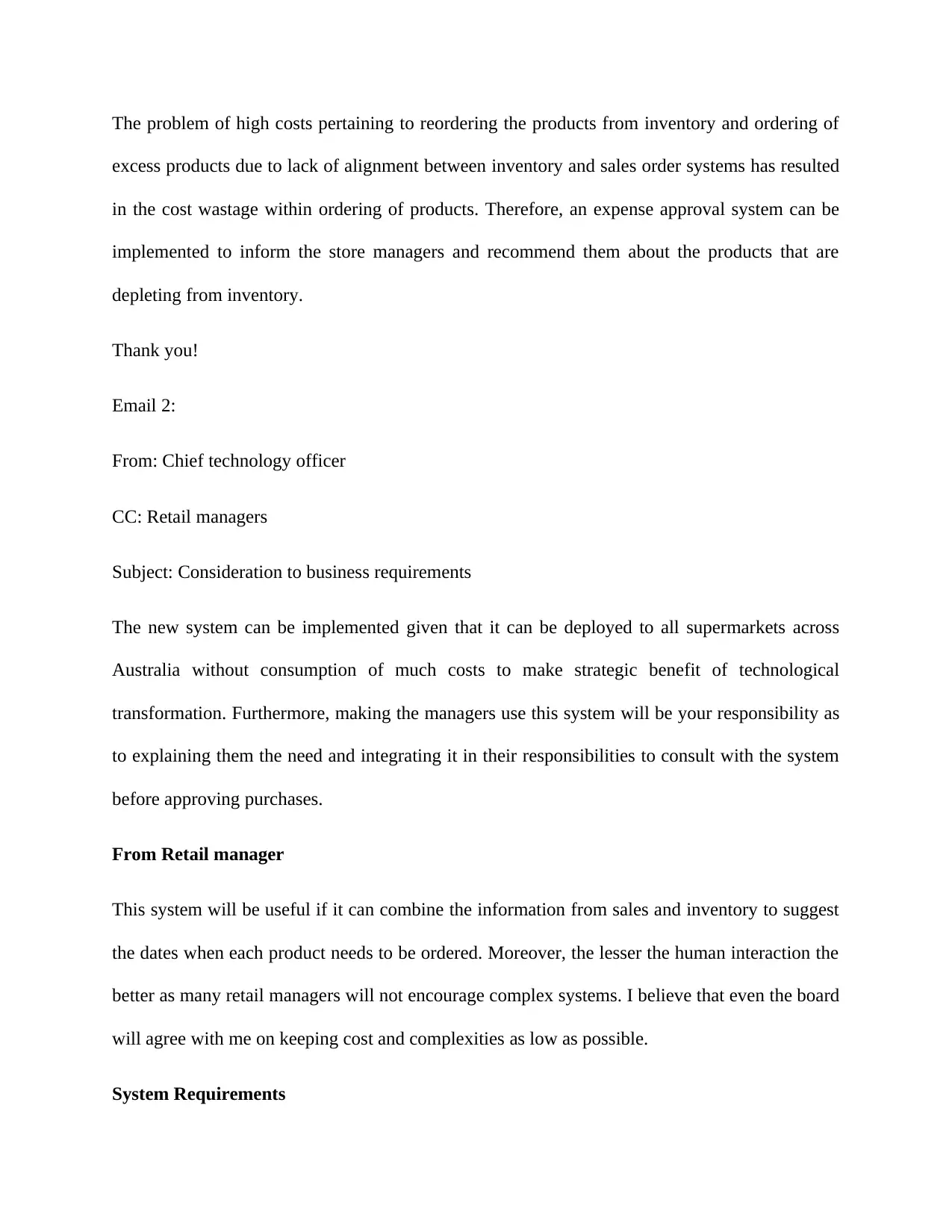
The problem of high costs pertaining to reordering the products from inventory and ordering of
excess products due to lack of alignment between inventory and sales order systems has resulted
in the cost wastage within ordering of products. Therefore, an expense approval system can be
implemented to inform the store managers and recommend them about the products that are
depleting from inventory.
Thank you!
Email 2:
From: Chief technology officer
CC: Retail managers
Subject: Consideration to business requirements
The new system can be implemented given that it can be deployed to all supermarkets across
Australia without consumption of much costs to make strategic benefit of technological
transformation. Furthermore, making the managers use this system will be your responsibility as
to explaining them the need and integrating it in their responsibilities to consult with the system
before approving purchases.
From Retail manager
This system will be useful if it can combine the information from sales and inventory to suggest
the dates when each product needs to be ordered. Moreover, the lesser the human interaction the
better as many retail managers will not encourage complex systems. I believe that even the board
will agree with me on keeping cost and complexities as low as possible.
System Requirements
excess products due to lack of alignment between inventory and sales order systems has resulted
in the cost wastage within ordering of products. Therefore, an expense approval system can be
implemented to inform the store managers and recommend them about the products that are
depleting from inventory.
Thank you!
Email 2:
From: Chief technology officer
CC: Retail managers
Subject: Consideration to business requirements
The new system can be implemented given that it can be deployed to all supermarkets across
Australia without consumption of much costs to make strategic benefit of technological
transformation. Furthermore, making the managers use this system will be your responsibility as
to explaining them the need and integrating it in their responsibilities to consult with the system
before approving purchases.
From Retail manager
This system will be useful if it can combine the information from sales and inventory to suggest
the dates when each product needs to be ordered. Moreover, the lesser the human interaction the
better as many retail managers will not encourage complex systems. I believe that even the board
will agree with me on keeping cost and complexities as low as possible.
System Requirements
⊘ This is a preview!⊘
Do you want full access?
Subscribe today to unlock all pages.

Trusted by 1+ million students worldwide

Size of the system
The system is required to be deployed to all retail locations through cloud due to which large
scale system needs to be developed
Number and type of users
The retail managers will be responsible to utilize the system in order to make informed decisions.
As the new expense approval system will be implemented organization wide, it will be deployed
across 995 supermarkets. Therefore, a manager for each store will operate the system indicating
total of 995 users.
Purpose and nature of system
The purpose of new expense approval system is to regulate the expenses of the 995 retail
supermarkets of Woolworths and assisting the respective store managers to approve only the
items required (Chang, 2016). This administrative system is part of the decision support systems
to assist the organizational management with making informed decisions based on data.
Ease of use versus complexity
The system will be integrated with the inventory and sales order system to provide
recommendations to store managers on approving expense for only near or out of stock products
(Fredericks et al., 2017). The system will present recommendations for purchases with only
human intervention required of approving the product.
Compatibility and features
New expense approval system requires to be compatible with both new and legacy systems of
Woolworths to ensure that the need for upgrading the existing systems do not arise. Therefore, a
The system is required to be deployed to all retail locations through cloud due to which large
scale system needs to be developed
Number and type of users
The retail managers will be responsible to utilize the system in order to make informed decisions.
As the new expense approval system will be implemented organization wide, it will be deployed
across 995 supermarkets. Therefore, a manager for each store will operate the system indicating
total of 995 users.
Purpose and nature of system
The purpose of new expense approval system is to regulate the expenses of the 995 retail
supermarkets of Woolworths and assisting the respective store managers to approve only the
items required (Chang, 2016). This administrative system is part of the decision support systems
to assist the organizational management with making informed decisions based on data.
Ease of use versus complexity
The system will be integrated with the inventory and sales order system to provide
recommendations to store managers on approving expense for only near or out of stock products
(Fredericks et al., 2017). The system will present recommendations for purchases with only
human intervention required of approving the product.
Compatibility and features
New expense approval system requires to be compatible with both new and legacy systems of
Woolworths to ensure that the need for upgrading the existing systems do not arise. Therefore, a
Paraphrase This Document
Need a fresh take? Get an instant paraphrase of this document with our AI Paraphraser
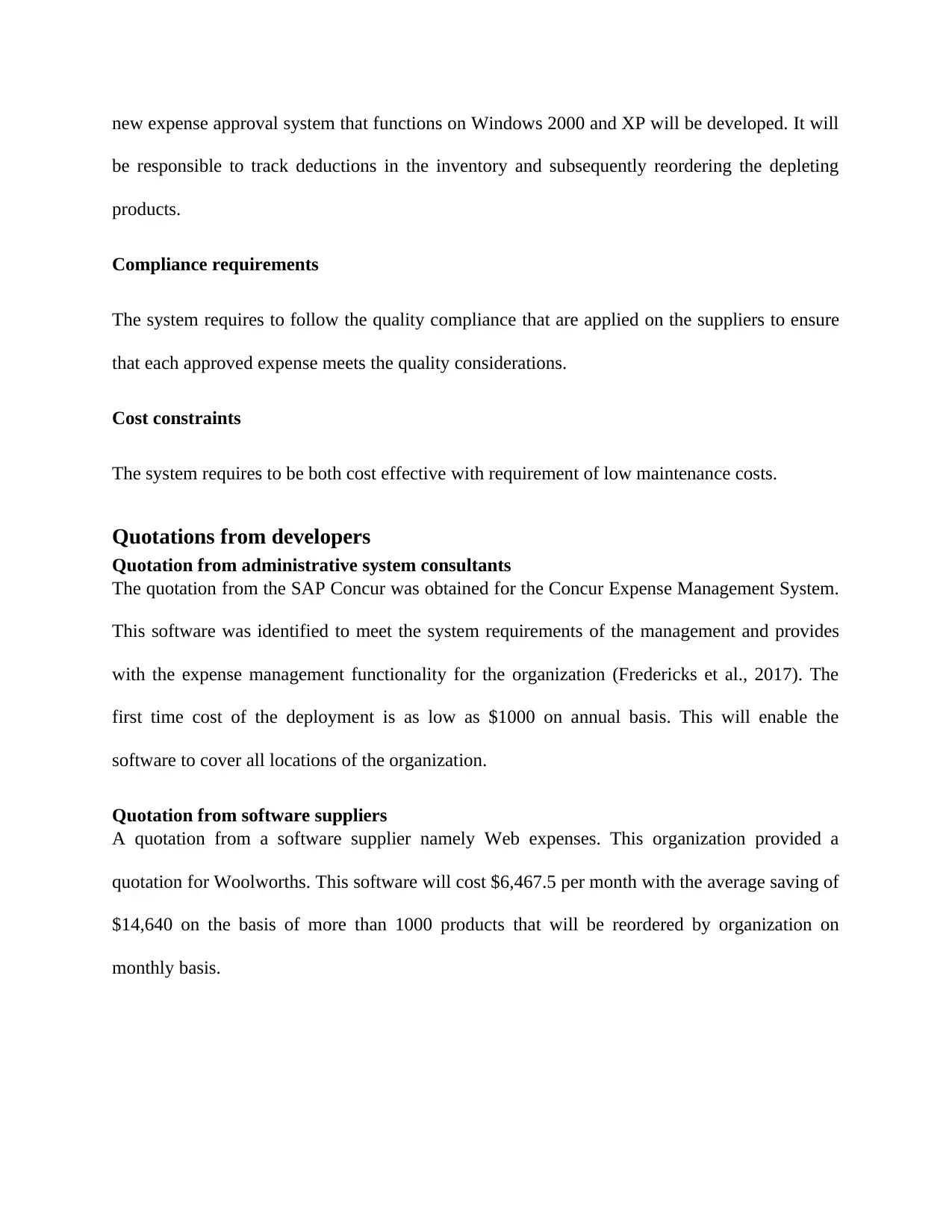
new expense approval system that functions on Windows 2000 and XP will be developed. It will
be responsible to track deductions in the inventory and subsequently reordering the depleting
products.
Compliance requirements
The system requires to follow the quality compliance that are applied on the suppliers to ensure
that each approved expense meets the quality considerations.
Cost constraints
The system requires to be both cost effective with requirement of low maintenance costs.
Quotations from developers
Quotation from administrative system consultants
The quotation from the SAP Concur was obtained for the Concur Expense Management System.
This software was identified to meet the system requirements of the management and provides
with the expense management functionality for the organization (Fredericks et al., 2017). The
first time cost of the deployment is as low as $1000 on annual basis. This will enable the
software to cover all locations of the organization.
Quotation from software suppliers
A quotation from a software supplier namely Web expenses. This organization provided a
quotation for Woolworths. This software will cost $6,467.5 per month with the average saving of
$14,640 on the basis of more than 1000 products that will be reordered by organization on
monthly basis.
be responsible to track deductions in the inventory and subsequently reordering the depleting
products.
Compliance requirements
The system requires to follow the quality compliance that are applied on the suppliers to ensure
that each approved expense meets the quality considerations.
Cost constraints
The system requires to be both cost effective with requirement of low maintenance costs.
Quotations from developers
Quotation from administrative system consultants
The quotation from the SAP Concur was obtained for the Concur Expense Management System.
This software was identified to meet the system requirements of the management and provides
with the expense management functionality for the organization (Fredericks et al., 2017). The
first time cost of the deployment is as low as $1000 on annual basis. This will enable the
software to cover all locations of the organization.
Quotation from software suppliers
A quotation from a software supplier namely Web expenses. This organization provided a
quotation for Woolworths. This software will cost $6,467.5 per month with the average saving of
$14,640 on the basis of more than 1000 products that will be reordered by organization on
monthly basis.
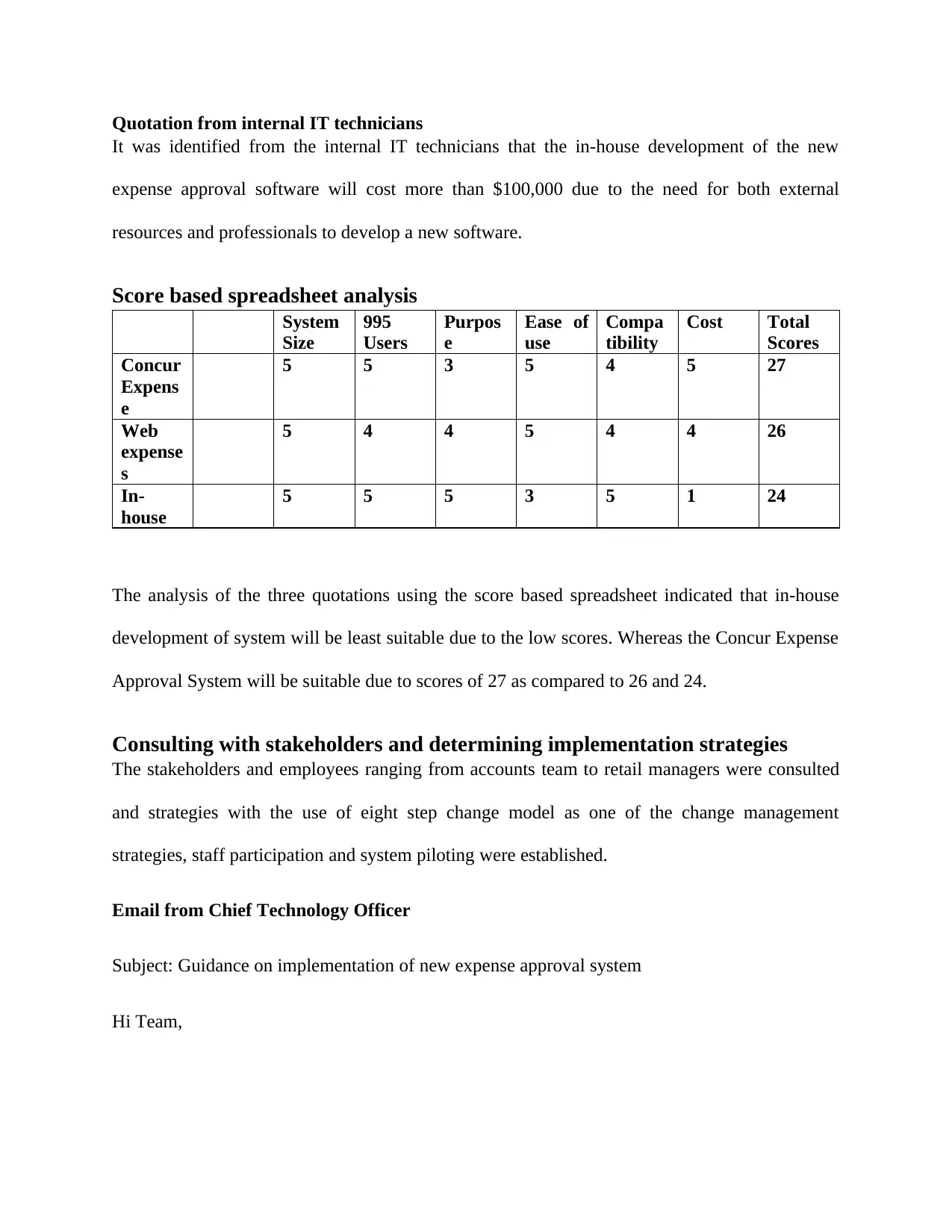
Quotation from internal IT technicians
It was identified from the internal IT technicians that the in-house development of the new
expense approval software will cost more than $100,000 due to the need for both external
resources and professionals to develop a new software.
Score based spreadsheet analysis
System
Size
995
Users
Purpos
e
Ease of
use
Compa
tibility
Cost Total
Scores
Concur
Expens
e
5 5 3 5 4 5 27
Web
expense
s
5 4 4 5 4 4 26
In-
house
5 5 5 3 5 1 24
The analysis of the three quotations using the score based spreadsheet indicated that in-house
development of system will be least suitable due to the low scores. Whereas the Concur Expense
Approval System will be suitable due to scores of 27 as compared to 26 and 24.
Consulting with stakeholders and determining implementation strategies
The stakeholders and employees ranging from accounts team to retail managers were consulted
and strategies with the use of eight step change model as one of the change management
strategies, staff participation and system piloting were established.
Email from Chief Technology Officer
Subject: Guidance on implementation of new expense approval system
Hi Team,
It was identified from the internal IT technicians that the in-house development of the new
expense approval software will cost more than $100,000 due to the need for both external
resources and professionals to develop a new software.
Score based spreadsheet analysis
System
Size
995
Users
Purpos
e
Ease of
use
Compa
tibility
Cost Total
Scores
Concur
Expens
e
5 5 3 5 4 5 27
Web
expense
s
5 4 4 5 4 4 26
In-
house
5 5 5 3 5 1 24
The analysis of the three quotations using the score based spreadsheet indicated that in-house
development of system will be least suitable due to the low scores. Whereas the Concur Expense
Approval System will be suitable due to scores of 27 as compared to 26 and 24.
Consulting with stakeholders and determining implementation strategies
The stakeholders and employees ranging from accounts team to retail managers were consulted
and strategies with the use of eight step change model as one of the change management
strategies, staff participation and system piloting were established.
Email from Chief Technology Officer
Subject: Guidance on implementation of new expense approval system
Hi Team,
⊘ This is a preview!⊘
Do you want full access?
Subscribe today to unlock all pages.

Trusted by 1+ million students worldwide
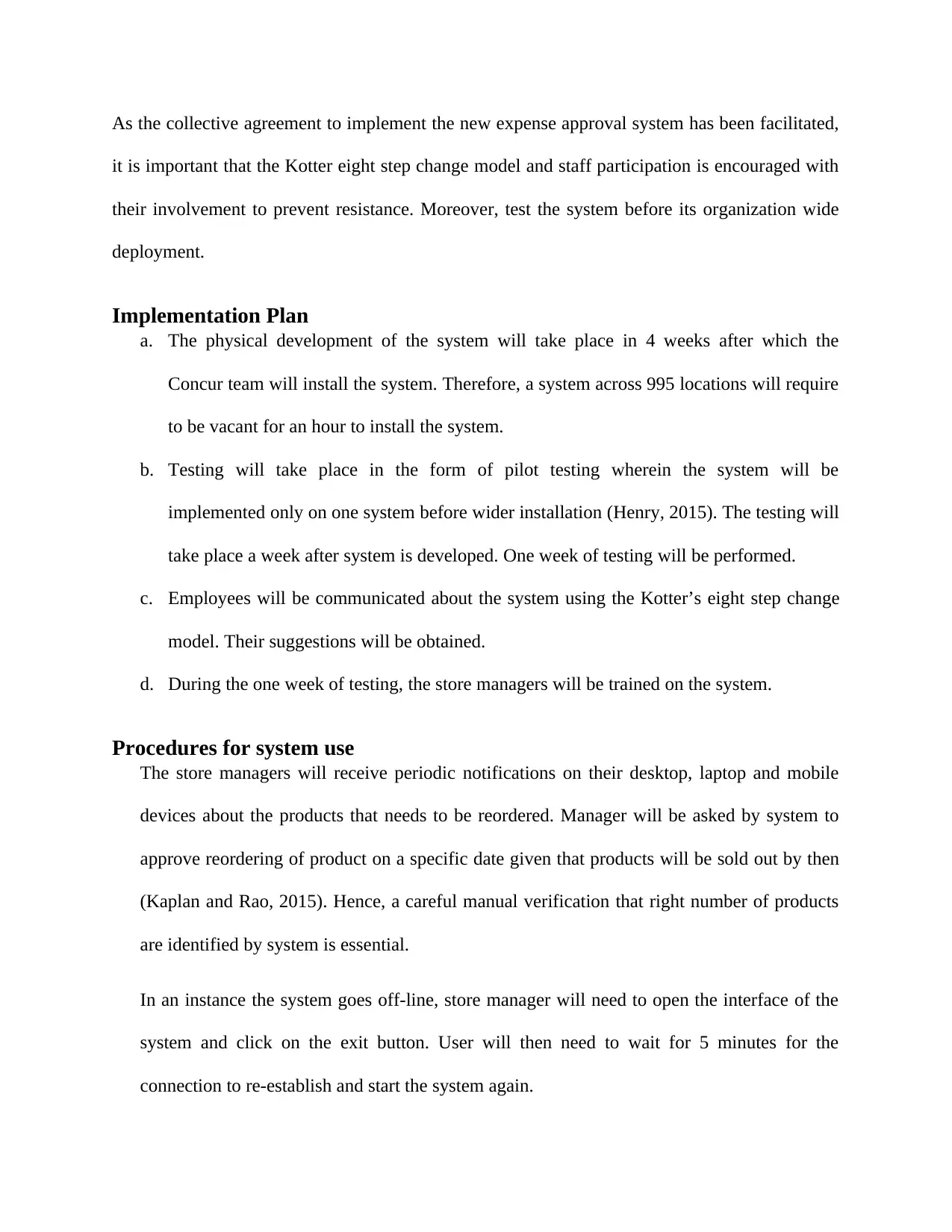
As the collective agreement to implement the new expense approval system has been facilitated,
it is important that the Kotter eight step change model and staff participation is encouraged with
their involvement to prevent resistance. Moreover, test the system before its organization wide
deployment.
Implementation Plan
a. The physical development of the system will take place in 4 weeks after which the
Concur team will install the system. Therefore, a system across 995 locations will require
to be vacant for an hour to install the system.
b. Testing will take place in the form of pilot testing wherein the system will be
implemented only on one system before wider installation (Henry, 2015). The testing will
take place a week after system is developed. One week of testing will be performed.
c. Employees will be communicated about the system using the Kotter’s eight step change
model. Their suggestions will be obtained.
d. During the one week of testing, the store managers will be trained on the system.
Procedures for system use
The store managers will receive periodic notifications on their desktop, laptop and mobile
devices about the products that needs to be reordered. Manager will be asked by system to
approve reordering of product on a specific date given that products will be sold out by then
(Kaplan and Rao, 2015). Hence, a careful manual verification that right number of products
are identified by system is essential.
In an instance the system goes off-line, store manager will need to open the interface of the
system and click on the exit button. User will then need to wait for 5 minutes for the
connection to re-establish and start the system again.
it is important that the Kotter eight step change model and staff participation is encouraged with
their involvement to prevent resistance. Moreover, test the system before its organization wide
deployment.
Implementation Plan
a. The physical development of the system will take place in 4 weeks after which the
Concur team will install the system. Therefore, a system across 995 locations will require
to be vacant for an hour to install the system.
b. Testing will take place in the form of pilot testing wherein the system will be
implemented only on one system before wider installation (Henry, 2015). The testing will
take place a week after system is developed. One week of testing will be performed.
c. Employees will be communicated about the system using the Kotter’s eight step change
model. Their suggestions will be obtained.
d. During the one week of testing, the store managers will be trained on the system.
Procedures for system use
The store managers will receive periodic notifications on their desktop, laptop and mobile
devices about the products that needs to be reordered. Manager will be asked by system to
approve reordering of product on a specific date given that products will be sold out by then
(Kaplan and Rao, 2015). Hence, a careful manual verification that right number of products
are identified by system is essential.
In an instance the system goes off-line, store manager will need to open the interface of the
system and click on the exit button. User will then need to wait for 5 minutes for the
connection to re-establish and start the system again.
Paraphrase This Document
Need a fresh take? Get an instant paraphrase of this document with our AI Paraphraser
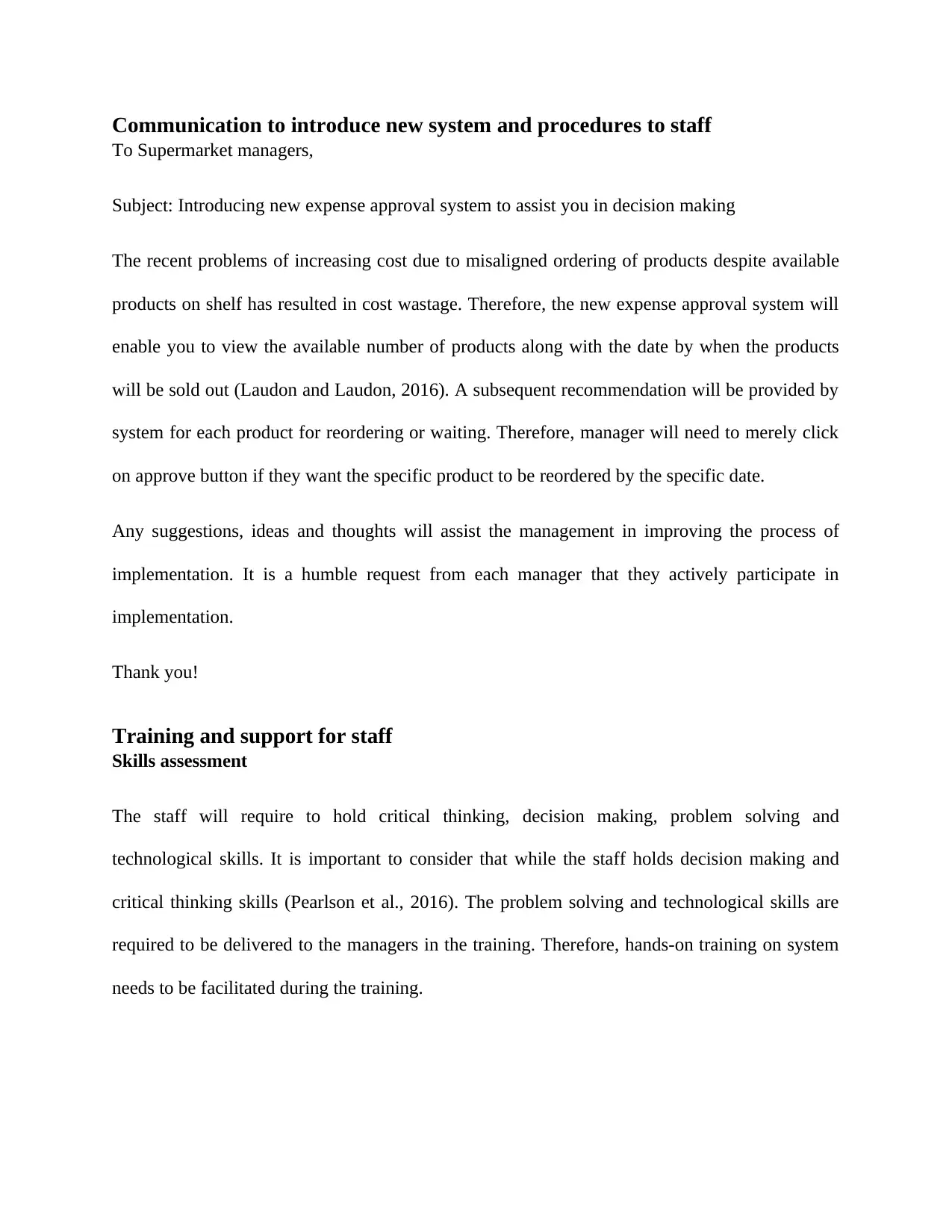
Communication to introduce new system and procedures to staff
To Supermarket managers,
Subject: Introducing new expense approval system to assist you in decision making
The recent problems of increasing cost due to misaligned ordering of products despite available
products on shelf has resulted in cost wastage. Therefore, the new expense approval system will
enable you to view the available number of products along with the date by when the products
will be sold out (Laudon and Laudon, 2016). A subsequent recommendation will be provided by
system for each product for reordering or waiting. Therefore, manager will need to merely click
on approve button if they want the specific product to be reordered by the specific date.
Any suggestions, ideas and thoughts will assist the management in improving the process of
implementation. It is a humble request from each manager that they actively participate in
implementation.
Thank you!
Training and support for staff
Skills assessment
The staff will require to hold critical thinking, decision making, problem solving and
technological skills. It is important to consider that while the staff holds decision making and
critical thinking skills (Pearlson et al., 2016). The problem solving and technological skills are
required to be delivered to the managers in the training. Therefore, hands-on training on system
needs to be facilitated during the training.
To Supermarket managers,
Subject: Introducing new expense approval system to assist you in decision making
The recent problems of increasing cost due to misaligned ordering of products despite available
products on shelf has resulted in cost wastage. Therefore, the new expense approval system will
enable you to view the available number of products along with the date by when the products
will be sold out (Laudon and Laudon, 2016). A subsequent recommendation will be provided by
system for each product for reordering or waiting. Therefore, manager will need to merely click
on approve button if they want the specific product to be reordered by the specific date.
Any suggestions, ideas and thoughts will assist the management in improving the process of
implementation. It is a humble request from each manager that they actively participate in
implementation.
Thank you!
Training and support for staff
Skills assessment
The staff will require to hold critical thinking, decision making, problem solving and
technological skills. It is important to consider that while the staff holds decision making and
critical thinking skills (Pearlson et al., 2016). The problem solving and technological skills are
required to be delivered to the managers in the training. Therefore, hands-on training on system
needs to be facilitated during the training.

Risk management plan
The compliance risks of selecting products or suppliers with inferior quality can be mitigated as
the manager will need to consult procurement policy before approving recommendations. The
need for modifications presents marginal risks as the system holds high degree of customizability
(Rittinghouse and Ransome, 2016). Furthermore, lack of training along with lack of confidence
will be mitigated with the training. The loss of productivity can be prevented with recoding data
on week long pilot implementation.
It is essential that the legislative requirements pertaining to the procurement policies of the
organization and consideration to the high quality with respect to the purchase decisions and
suppliers.
The compliance risks of selecting products or suppliers with inferior quality can be mitigated as
the manager will need to consult procurement policy before approving recommendations. The
need for modifications presents marginal risks as the system holds high degree of customizability
(Rittinghouse and Ransome, 2016). Furthermore, lack of training along with lack of confidence
will be mitigated with the training. The loss of productivity can be prevented with recoding data
on week long pilot implementation.
It is essential that the legislative requirements pertaining to the procurement policies of the
organization and consideration to the high quality with respect to the purchase decisions and
suppliers.
⊘ This is a preview!⊘
Do you want full access?
Subscribe today to unlock all pages.

Trusted by 1+ million students worldwide
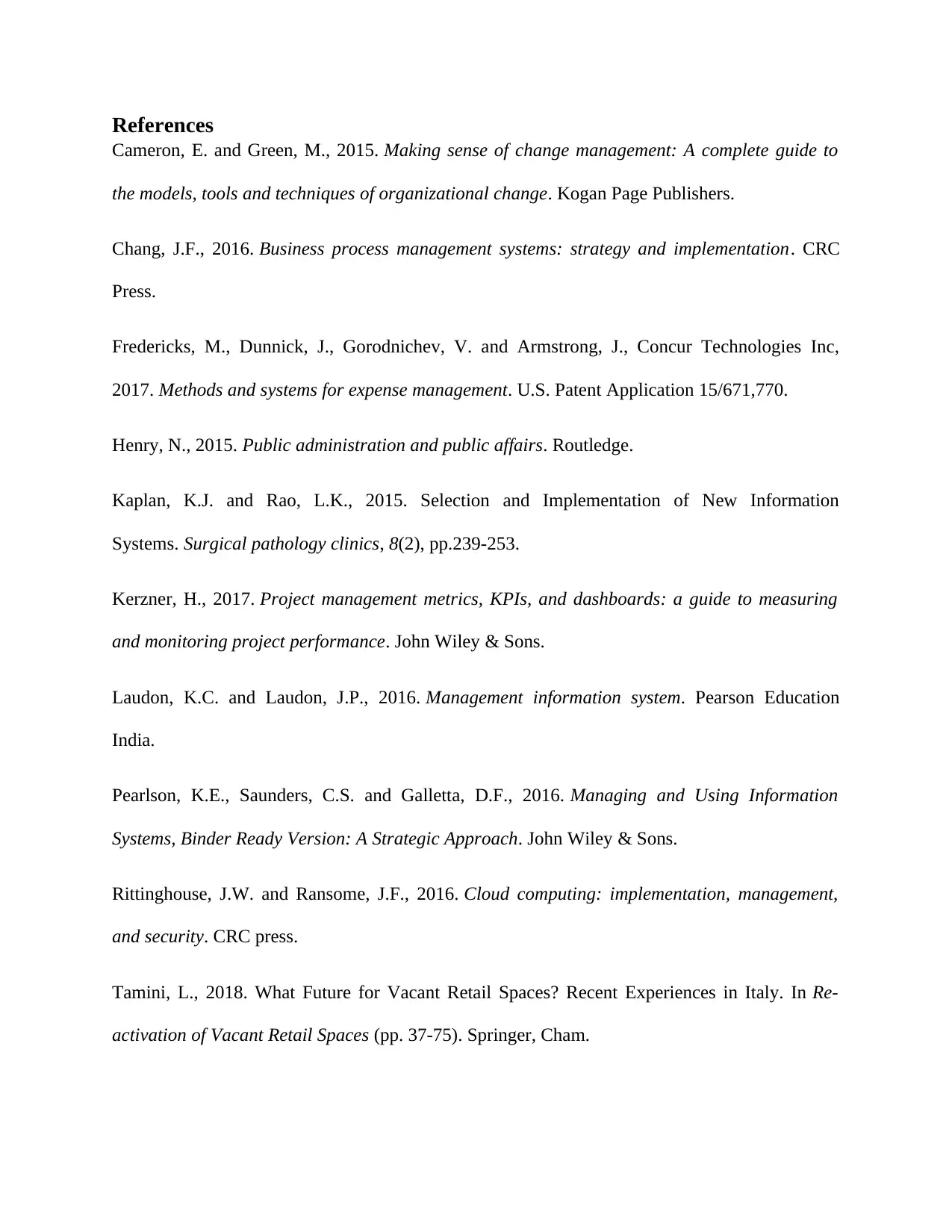
References
Cameron, E. and Green, M., 2015. Making sense of change management: A complete guide to
the models, tools and techniques of organizational change. Kogan Page Publishers.
Chang, J.F., 2016. Business process management systems: strategy and implementation. CRC
Press.
Fredericks, M., Dunnick, J., Gorodnichev, V. and Armstrong, J., Concur Technologies Inc,
2017. Methods and systems for expense management. U.S. Patent Application 15/671,770.
Henry, N., 2015. Public administration and public affairs. Routledge.
Kaplan, K.J. and Rao, L.K., 2015. Selection and Implementation of New Information
Systems. Surgical pathology clinics, 8(2), pp.239-253.
Kerzner, H., 2017. Project management metrics, KPIs, and dashboards: a guide to measuring
and monitoring project performance. John Wiley & Sons.
Laudon, K.C. and Laudon, J.P., 2016. Management information system. Pearson Education
India.
Pearlson, K.E., Saunders, C.S. and Galletta, D.F., 2016. Managing and Using Information
Systems, Binder Ready Version: A Strategic Approach. John Wiley & Sons.
Rittinghouse, J.W. and Ransome, J.F., 2016. Cloud computing: implementation, management,
and security. CRC press.
Tamini, L., 2018. What Future for Vacant Retail Spaces? Recent Experiences in Italy. In Re-
activation of Vacant Retail Spaces (pp. 37-75). Springer, Cham.
Cameron, E. and Green, M., 2015. Making sense of change management: A complete guide to
the models, tools and techniques of organizational change. Kogan Page Publishers.
Chang, J.F., 2016. Business process management systems: strategy and implementation. CRC
Press.
Fredericks, M., Dunnick, J., Gorodnichev, V. and Armstrong, J., Concur Technologies Inc,
2017. Methods and systems for expense management. U.S. Patent Application 15/671,770.
Henry, N., 2015. Public administration and public affairs. Routledge.
Kaplan, K.J. and Rao, L.K., 2015. Selection and Implementation of New Information
Systems. Surgical pathology clinics, 8(2), pp.239-253.
Kerzner, H., 2017. Project management metrics, KPIs, and dashboards: a guide to measuring
and monitoring project performance. John Wiley & Sons.
Laudon, K.C. and Laudon, J.P., 2016. Management information system. Pearson Education
India.
Pearlson, K.E., Saunders, C.S. and Galletta, D.F., 2016. Managing and Using Information
Systems, Binder Ready Version: A Strategic Approach. John Wiley & Sons.
Rittinghouse, J.W. and Ransome, J.F., 2016. Cloud computing: implementation, management,
and security. CRC press.
Tamini, L., 2018. What Future for Vacant Retail Spaces? Recent Experiences in Italy. In Re-
activation of Vacant Retail Spaces (pp. 37-75). Springer, Cham.
1 out of 10
Related Documents
Your All-in-One AI-Powered Toolkit for Academic Success.
+13062052269
info@desklib.com
Available 24*7 on WhatsApp / Email
![[object Object]](/_next/static/media/star-bottom.7253800d.svg)
Unlock your academic potential
Copyright © 2020–2025 A2Z Services. All Rights Reserved. Developed and managed by ZUCOL.





